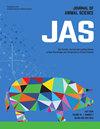Effects of increasing levels of benzoic acid fed to pigs on nitrogen utilization and metabolism affecting growth performance, ammonia emissions, and carcass characteristics
IF 2.7
2区 农林科学
Q1 AGRICULTURE, DAIRY & ANIMAL SCIENCE
引用次数: 0
Abstract
The objectives of this study were to investigate the effects of increasing levels of benzoic acid (BA) on nitrogen utilization and metabolism affecting growth performance, ammonia emissions, and carcass characteristics, and to determine the optimal levels of BA for the growth performance and carcass characteristics when fed to pigs from weaning to market. A total of 480 pigs (6.0 ± 1.5 kg) were assigned to 4 dietary treatments in a randomized complete block design with initial body weight and group as blocks, and were fed in 6 phases. Treatments included a basal diet with antibiotics (PC) and diets with three levels of BA (0.00, 0.50, and 1.00% BA) without antibiotics. The PC increased (P < 0.05) the ADG and G:F during the overall period compared to no BA supplementation. Increasing levels of BA increased (P < 0.05) overall ADG quadratically (maximum at 0.53% or 7.5 g/d of BA). Increasing levels of BA increased (P < 0.05) overall G:F quadratically (maximum at 0.57% or 8.1 g/d of BA). Increasing levels of BA tended to increase (linear, P = 0.096) N digestibility and increased (linear, P < 0.05) N retention. The BA supplementation at 1.00% decreased (P < 0.05) urine pH and aerial ammonia emission from manure compared to no BA supplementation in the 24 h collection period. The BA supplementation at 1.00% decreased (P < 0.05) rate of change in aerial ammonia emission compared to no BA supplementation in the 24 h collection period. The PC increased (P < 0.05) shrink weight, hot carcass weight, and first rib backfat compared to no BA supplementation. Increasing levels of BA decreased (P < 0.05) loin color and marbling score linearly and increased (P < 0.05) the loin eye area quadratically (maximum at 0.59% or 8.1 g/d of BA). In conclusion, supplementation of BA in feeds enhanced growth performance, improved N utilization, reduced urine pH, reduced aerial ammonia emissions, and improved carcass characteristics of pigs. Supplementation of BA at a range of 0.53 to 0.59% (corresponding to 7.5 to 8.1 g/d of BA based on overall ADFI) provided the optimal improvements in body weight gain, feed efficiency, and carcass characteristics when fed to pigs from weaning to market.求助全文
约1分钟内获得全文
求助全文
来源期刊

Journal of animal science
农林科学-奶制品与动物科学
CiteScore
4.80
自引率
12.10%
发文量
1589
审稿时长
3 months
期刊介绍:
The Journal of Animal Science (JAS) is the premier journal for animal science and serves as the leading source of new knowledge and perspective in this area. JAS publishes more than 500 fully reviewed research articles, invited reviews, technical notes, and letters to the editor each year.
Articles published in JAS encompass a broad range of research topics in animal production and fundamental aspects of genetics, nutrition, physiology, and preparation and utilization of animal products. Articles typically report research with beef cattle, companion animals, goats, horses, pigs, and sheep; however, studies involving other farm animals, aquatic and wildlife species, and laboratory animal species that address fundamental questions related to livestock and companion animal biology will be considered for publication.
 求助内容:
求助内容: 应助结果提醒方式:
应助结果提醒方式:


